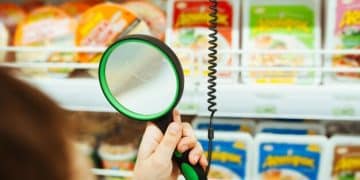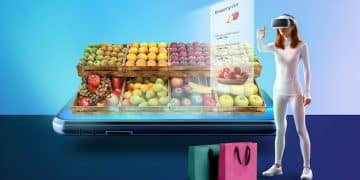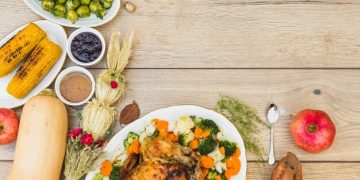The Ultimate Guide to Understanding Food Labels in 2025

The Ultimate Guide to Understanding Food Labels in 2025 unveils upcoming regulatory changes and consumer trends, empowering informed food choices. Expect enhanced transparency, clearer nutritional information, and innovative technologies to shape how we interpret food content.
Navigating the grocery store can be overwhelming, especially when trying to decipher food labels. With regulations constantly evolving and new dietary trends emerging, understanding what you’re putting into your body is more critical than ever. The Ultimate Guide to Understanding Food Labels in 2025 aims to simplify this process, providing clarity and empowering you to make healthier choices.
This guide will delve into the key components of food labels, upcoming changes, and how to interpret the information to align with your dietary goals. Let’s unlock the secrets hidden within those packages, ensuring you’re well-informed in 2025 and beyond.
What to Expect from Food Labels in 2025
As we approach 2025, food labels are poised to undergo significant transformations. These changes are driven by evolving consumer demands for greater transparency and more comprehensive nutritional information. Anticipate a more streamlined and user-friendly approach to understanding what’s in your food.
Key Regulatory Updates
Regulatory bodies are continually working to enhance the accuracy and clarity of food labels. Expect stricter guidelines regarding serving sizes, nutrient declarations, and allergen labeling. These updates aim to provide consumers with the most precise information possible.
Consumer Trends Shaping Labeling
Consumer preferences play a crucial role in shaping food labeling practices. With increasing interest in sustainability, plant-based diets, and clean eating, labels are adapting to highlight these aspects. Look for more certifications, claims, and ingredient disclosures that cater to these trends.
- Emphasis on Added Sugars: Labels will likely provide clearer information about the amount of added sugars in products, helping consumers manage their sugar intake.
- Highlighting Sustainable Practices: Expect more labels showcasing environmentally friendly sourcing and production methods.
- Improved Allergen Labeling: Regulations may tighten to ensure more comprehensive and easily understandable allergen information.
In conclusion, 2025 will usher in a new era of food labeling, characterized by enhanced transparency, accuracy, and responsiveness to consumer trends. By staying informed about these changes, you can confidently navigate the grocery store and make choices that align with your health and values.
Decoding the Nutrition Facts Panel in 2025
The Nutrition Facts panel is a cornerstone of food labeling, providing a detailed breakdown of a product’s nutritional content. Mastering this panel is essential for making informed dietary decisions. In 2025, anticipate further refinements to enhance its utility and clarity.
Understanding Serving Sizes
Serving sizes are a critical component of the Nutrition Facts panel. It’s important to recognize that the nutritional information provided is based on this serving size. Pay close attention to ensure you’re accurately assessing your intake.
Key Nutrients to Focus On
The Nutrition Facts panel highlights several key nutrients that can impact your health. These include calories, fat, saturated fat, trans fat, cholesterol, sodium, carbohydrates, fiber, sugar, protein, and various vitamins and minerals. Understanding these nutrients is crucial for maintaining a balanced diet.
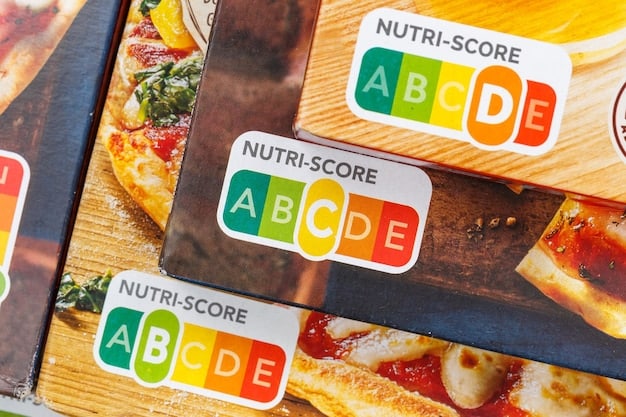
- Calories: Understand how many calories are in a serving and how it fits into your daily caloric needs.
- Fat: Differentiate between healthy and unhealthy fats, focusing on minimizing saturated and trans fats.
- Added Sugars: Monitor your intake of added sugars, which can contribute to various health issues.
In summary, the Nutrition Facts panel is a valuable tool for making informed food choices. By understanding serving sizes and focusing on key nutrients, you can effectively manage your diet and promote your overall health. In 2025, look for even clearer and more user-friendly panels that further simplify this process.
Ingredient Lists: Unlocking Hidden Secrets
The ingredient list is another vital component of food labels, providing a comprehensive inventory of everything a product contains. By carefully examining this list, you can uncover hidden ingredients and make more informed decisions about what you consume.
Deciphering Additives and Preservatives
Ingredient lists often include various additives and preservatives designed to enhance flavor, texture, or shelf life. While many of these are generally recognized as safe, it’s important to understand their purpose and potential impact on your health.
Identifying Common Allergens
For individuals with allergies, the ingredient list is a critical resource. Labels are required to clearly identify common allergens such as milk, eggs, peanuts, tree nuts, soy, wheat, fish, and shellfish. Always double-check the list, even if you’ve consumed the product before, as formulations can change.
The Importance of Reading Order
Ingredients are listed in descending order by weight, meaning the first ingredient is present in the largest quantity. This can provide valuable insights into the composition of the product. For instance, if sugar is listed as one of the first ingredients, it indicates that the product is likely high in sugar.
Ultimately, the ingredient list is a powerful tool for understanding what’s in your food. By deciphering additives and preservatives, identifying common allergens, and considering the order of ingredients, you can make more informed choices that align with your dietary needs and preferences.
Navigating Health Claims and Certifications
Food labels often feature various health claims and certifications designed to highlight specific attributes of a product. Understanding these claims and certifications can help you quickly assess the nutritional value and quality of the food.
Understanding Common Health Claims
Health claims are statements that describe the relationship between a food or food component and a health condition or disease. These claims are regulated by agencies like the Food and Drug Administration (FDA) to ensure they are truthful and not misleading.
Recognizing Reliable Certifications
Certifications are seals of approval from independent organizations that verify certain standards or qualities of a product. Look for certifications such as USDA Organic, Non-GMO Project Verified, and Certified Gluten-Free to ensure the product meets specific criteria.
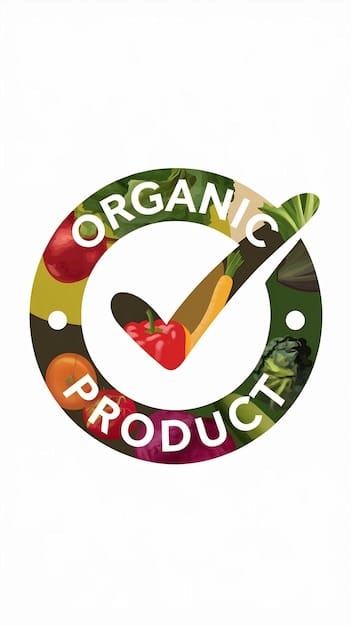
- Organic: Indicates that the product was produced using organic farming practices.
- Non-GMO: Confirms that the product does not contain genetically modified organisms.
- Gluten-Free: Assures that the product contains less than 20 parts per million of gluten.
To summarize, health claims and certifications can provide valuable information about a product’s nutritional value and quality. By understanding the meaning of these claims and recognizing reliable certifications, you can make more informed choices that align with your health goals and values.
The Role of Technology in Food Labeling in 2025
Technology is poised to revolutionize food labeling in 2025, offering innovative ways to access and interpret information. From QR codes to mobile apps, anticipate a more interactive and personalized approach to understanding food labels.
QR Codes and Mobile Apps
QR codes and mobile apps can provide instant access to detailed product information, including nutritional facts, ingredient lists, allergen information, and sustainability practices. By scanning a QR code with your smartphone, you can quickly access a wealth of information that goes beyond what’s printed on the label.
Personalized Nutrition Information
Technology can also enable personalized nutrition information. By inputting your dietary preferences, allergies, and health goals into a mobile app, you can receive tailored recommendations and alerts based on the food labels you scan. This can help you make more informed choices that align with your individual needs.
Blockchain Technology for Transparency
Blockchain technology can enhance transparency in the food supply chain, providing consumers with a verifiable record of a product’s origin, production methods, and transportation history. This can build trust and confidence in the accuracy of food labels.
In conclusion, technology is set to transform food labeling in 2025, offering more accessible, interactive, and personalized ways to understand the food we consume. By embracing these innovations, you can make more informed choices that support your health and values.
The Ultimate Guide to Understanding Food Labels in 2025: Preparing for the Future
As we look ahead to 2025, anticipating the future of food labels involves embracing both regulatory changes and technological advancements. With proactive knowledge, you can ensure you’re well-equipped to make informed dietary choices aligned with your health and lifestyle needs. The Ultimate Guide to Understanding Food Labels in 2025 provides the insights needed to navigate these evolving landscapes successfully.
Staying updated with regulatory updates, mastering the Nutrition Facts panel, and utilizing technological tools will empower consumers to make healthier food choices. By understanding the significance of ingredient lists and health claims, consumers can better decipher what’s truly in their food. Therefore, ongoing awareness and adaptation will define The Ultimate Guide to Understanding Food Labels in 2025.
| Key Point | Brief Description |
|---|---|
| ✅ Regulatory Changes | Expect enhanced transparency and stricter guidelines. |
| 📊 Nutrition Facts Panel | Understand serving sizes and key nutrients. |
| 🌿 Ingredient Lists | Identify additives and common allergens. |
| 📱 Technology | Utilize QR codes for detailed product information. |
Frequently Asked Questions
By 2025, expect clearer labeling of added sugars, more prominent allergen warnings, and enhanced information on sustainable practices. These changes aim to provide consumers with better insights.
Focus on serving sizes and key nutrients like calories, fat, sugar, and fiber. Compare different products to find the healthiest options that meet your dietary needs.
The ingredient list reveals additives, preservatives, and allergens. Understanding the order of ingredients helps assess the amount of each component in the product, aligning with The Ultimate Guide to Understanding Food Labels in 2025.
Look for certifications such as USDA Organic, Non-GMO Project Verified, and Certified Gluten-Free. These seals of approval indicate that the product meets specific standards.
QR codes and mobile apps will offer instant access to detailed product information and personalized nutrition advice. Blockchain may also enhance transparency in the food supply chain, ensuring the integrity of labels.
Conclusion
As 2025 approaches, understanding food labels becomes increasingly crucial for making informed dietary choices. The Ultimate Guide to Understanding Food Labels in 2025 equips you with the knowledge to navigate regulatory changes, interpret nutrition panels, and leverage technology for better health.
By staying informed and proactive, you can confidently select foods that align with your health goals and values. Use this guide as a resource to empower your decisions and ensure a healthier future.

